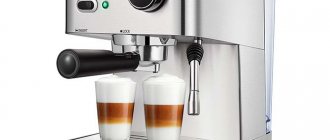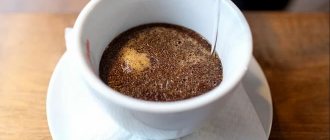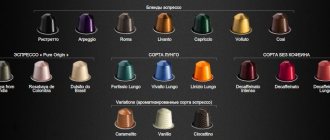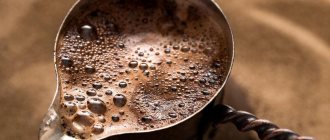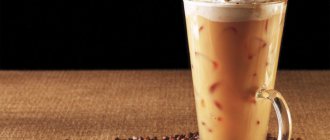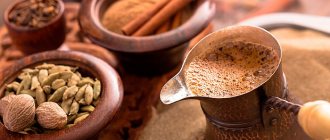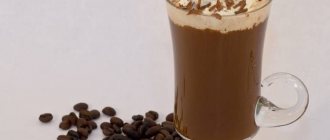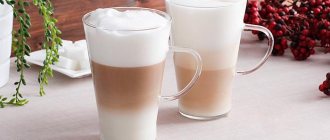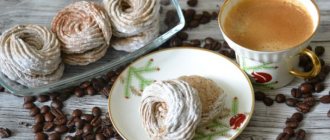History of ice coffee
Back in the 17th century, Dutch colonists in the East Indies escaped the heat with chilled coffee. In Europe, cold coffee drink came into fashion in the 40s of the 19th century and was called mazagran. During the long siege, the French soldiers of the garrison of the Algerian fortress of Mazagran fortified their strength with cold coffee sweetened with syrup.
Honore de Balzac explained his incredible ability to work by constantly drinking coffee infusion. The great writer preferred to pour cold water over the ground beans and argued that such coffee invigorates better than traditionally brewed coffee. Modern scientists have confirmed that the classic was right: cold brew coffee actually has more caffeine and less acids.
The name “ice coffee” first appeared in the 20s of the 20th century, when the Joint Committee on Coffee Advertising in the United States carried out an aggressive marketing campaign for the drink. Later, iced coffee entered the menu of large fast food chains: Burger King, Dunkin' Donuts, Starbucks.
Different countries have their own traditions of preparing and serving ice coffee:
- in Australia - with ice cream and whipped cream, sometimes with syrup;
- Ice Capps are popular in Canada - ice cappuccino, which is included in the menu of the large Tim Hortons coffee shop chain;
- In Chile, iced coffee is called café helado. It features espresso with ice cream, vanilla and cinnamon;
- in Germany the drink is called Eiskaffee and served with whipped cream;
- in India, instant coffee is whipped in a blender with cold or frozen milk;
- in Japan - with syrup and milk;
- in Slovenia the drink is called ledena kava. It consists of a double espresso with vanilla ice cream, whipped cream, garnished with flaked almonds or grated chocolate;
- in Sri Lanka - with cognac. The drink is always served at weddings.
During an exhibition held in Greece in 1957, Nescafe representative Dimitrios Vakondios did not find boiling water. Therefore, he beat instant coffee with a mixer (according to other sources - a dry coffee-milk drink) with sugar and a small amount of water. He filled the foam with cold water and added ice to the glass. This is how one of the most famous varieties of iced coffee, frappe, was prepared for the first time.
After the 2004 Olympic Games, frappe fashion spread throughout the world. Now the drink is prepared not only with instant, but also with natural coffee, liqueurs, syrups, and whipped cream are added to it. Starbucks specialists have invented the Frappuccino drink. Unlike frappe, it is not served with whole ice cubes, but is blended with a blender until the ice turns into crumbs.
Coffee bar "Brownie"
“Banana cocoa” (180 rubles) . No, it's not the waitress's fault, that's what it says. The drink looks good - under a thick head of cream, decorated with a slice of unpeeled banana, there is a drink at just the right temperature that allows you to enjoy cocoa without fear of a straw burning your palate. A little more powder than needed, but the sweetness is just right - 100% hit the spot. Not bad, although no frills.
"Banana cocoa"
Photo: Newslab.ru
Methods for preparing ice coffee
There are several ways to prepare the coffee base for iced coffee:
- classic method - coffee is brewed in any way, then cooled and served with ice cubes;
- rapid cooling – freshly brewed coffee is instantly cooled using a heat exchange system;
- cold brew - ground coffee is poured with water at room temperature in a ratio of 1:4 or 1:5 and left for 3-24 hours. The drink is then filtered and mixed with ice. This method was used by Balzac;
- cold brew “hot bloom” - coffee is poured with a small amount of hot water, and when gas bubbles come to the surface, cold water is added. After the gas is removed, extraction proceeds more evenly;
- slow-drip cold brew - cold water slowly drips onto a coffee tablet, and after passing through it, flows into the vessel;
- Japanese method (flash brew) - coffee, which is brewed in a Chemex or pour-over, is poured directly onto ice;
- freezing – brewed coffee is frozen and then topped with milk before serving.
Ingredients for iced coffee
To make iced coffee, it is better to use inexpensive blends of 100% Arabica coffee. If milk, cream or ice cream is added to the drink, then blends with 10–20% robusta are also suitable.
Grinding depends on the cooking method. But you shouldn’t grind the grains into dust: there should be no grains of grounds in the drink. When brewing coffee in a French press or Turk, the drink will have to be additionally filtered.
Roasting level: light or medium (Viennese). If the coffee is roasted too dark, it will be very bitter, but in combination with milk, this taste is not for everyone.
Water for both coffee and freezing should be bottled, with a mineralization in the range of 75–250 mg/l, optimally 150 mg/l.
Milk, cream and ice cream can be of any fat content.
Correction of unwanted low tide
Have you ever had problems with yellowness, redness or redness when dyeing? Or maybe even green strands appeared? This confusion has a completely logical explanation. By making changes in appearance, we remove the natural pigment - a combination of eu-melanins (blue and red) and pheo-melanins (red and yellow) - and create the so-called background. When transitioning to chestnut, it will be ruby or orange in color, and in our case, light reddish. If all color rules are followed, redness should not appear, but what to do if the toning turns out to be uneven in color? Professional proofreaders will come to the rescue. They are produced by “Kapus”, “Estelle”, “Vella”, “Igora” and others. The purpose of the cream is to remove unwanted pigment and highlight the main one.
To get the perfect look, you need to follow all the rules of coloring.
Varieties:
- Ash (ash) – will remove yellowness and redness;
- Red (red) – neutralizes greens;
- Blue (blue or cyan) - also fights yellow spots;
- Green is the most complex corrector, it removes redness, but if you overdose there is a risk of darkening it.
Advice! The miracle remedy is added according to the “rule of 10”: 1 cm at level 10, 2 cm at level 9, and so on. But don’t overdo it, otherwise you might get too dark.
If the result does not meet expectations, use tinting agents
Characteristics of ice coffee
| Bean varieties | A mixture of several varieties of Arabica, possible addition of up to 20% Robusta |
| Roasting degree | Light to Medium (Full City or Viennese) |
| Grinding | Depends on the brewing method, but not into dust |
| Ready coffee temperature | +10 to +20 °C |
| Cooking time | 20–30 minutes |
| Portion output volume, ml | 180 – 200 ml |
| Caffeine content (strength) | 100–136 mg per serving if espresso is used as base |
| Recommended intake (servings per day) | 1 |
| Maximum permissible norm (servings per day) | 2 |
| Calorie content | 76.1–97.5 kcal per serving |
| Calories with sugar | 95.45–116.85 kcal - a serving of coffee with 5 g of sugar (1 sticker) |
In cafes, the basis for iced coffee is usually chilled double espresso. At home, you can use coffee brewed in any way as a base, the main thing is that it is strong. To make the coffee cool faster, place the container with it in a bowl of cold water.
Calorie content of coffee in famous chains
Each chain restaurant has different standards for cooking recipes.
McDonald's
Ingredients of a regular cappuccino from McDonald's:
- roasted bean coffee;
- milk;
- water.
Ingredients of Ice Cappuccino from McDonald's:
- roasted bean coffee;
- milk;
- water;
- ice;
- caramel syrup.
Calorie content depending on the composition and volume of the drink:
| McDonald's | Volume | Kcal |
| Cappuccino | 0,1 | 37.5 |
| 0.2 | 75 | |
| 0.3 | 125 | |
| Cappuccino Ice | 0.1 | 55 |
| 0.2 | 113 | |
| 0.3 | 169 |
The McDonald's restaurant chain uses Arabica and Robusta beans to make coffee. Arabica gives the drink a distinct coffee aroma, and robusta adds strength.
KFC
KFC cappuccino includes:
- ground coffee;
- water;
- milk.
Calorie content depending on the volume of the drink:
| Volume | Kcal |
| 0.1 | 74.1 |
| 0.3 | 180 |
| 0.4 | 216 |
Burger King
Compound:
- black coffee;
- frothed milk.
Calorie content depending on the volume of the drink:
| Volume | Kcal |
| 0.1 | 48 |
| 0.3 | 143.4 |
Starbucks
The Starbucks coffee shop serves 2 types of drinks: Grande without Sugar and Cappuccino low-fat.
Calorie content depending on the volume and composition of the drink:
| Starbucks | Volume | Kcal |
| Grande without Sugar | 0.1 | 38.2 |
| Grande without Sugar | 0.35 | 140 |
| Cappuccino low fat | 0.1 | 20 |
It is believed that Starbucks sells one of the lowest-calorie types of coffee using skim milk and adding natural low-calorie products as sweeteners.
Chocolate girl
The Shokoladnitsa coffee shop serves 5 types of cappuccino:
- Classical
- Light - with skim milk
- Strong – double shot of espresso
- Caramel - contains caramel topping and vanilla syrup
- Ice cappuccino - a refreshing version of the drink with added ice
Calorie content depending on the volume and composition of the drink:
| Chocolate girl | Volume | Kcal |
| Classical | 0.1 | 35 |
| 0.32 | 125 | |
| Light | 0.1 | 39 |
| 0.32 | 94 | |
| Strong | 0.1 | 65 |
| 0.32 | 81 | |
| Caramel | 0.1 | 120 |
| 0.32 | 199 | |
| Ice | 0.1 | 80 |
| 0.31 | 188 |
Cappuccino from a machine
Coffee machines dispense a drink with a volume of approximately 200 ml. To know exactly what calorie content it contains, you need to determine what kind of coffee and milk the product is made from. If the coffee machine uses natural beans and milk with a fat content of 2.5%, then the calorie content will be approximately 64 Kcal per 200 ml of drink.
Classic ice coffee recipe
Ingredients:
- 50 ml black coffee;
- 100 ml chilled milk;
- 40 g cream;
- 3–4 ice cubes;
- sugar, grated chocolate - to taste.
Cooking technology
- Brew coffee, add sugar if necessary.
- Cool the coffee.
- Whip the cream into a stiff foam.
- Mix coffee with milk.
- Place 3-4 ice cubes in a glass.
- Pour in the coffee and milk mixture.
- Place cream on top and decorate with chocolate.
Ice coffee without milk
Ingredients:
- 100 ml coffee;
- 3–4 ice cubes;
- sugar - to taste;
- slice of lemon.
Recipe
- Brew coffee, add sugar.
- Cool the coffee.
- Pour coffee into a glass with ice.
- Garnish with a slice of lemon.
- You can add cinnamon, anise, vanilla, cardamom or fruit syrup to the water before freezing.
Without milk and cream
Decorating drinks
They require tall glass glasses, cocktail straws and spoons. Any cookies, waffles, desserts with cream cheese are served with drinks.
Decorated in different ways:
- ice cream;
- whipped cream;
- toppings;
- cinnamon powder;
- chocolate, etc.
Vietnamese iced coffee with tapioca
Tapioca is a sago grain (balls of starch) made from cassava roots. In this recipe, tapioca serves as a thickener, giving the coffee an unusual texture. If you don't have tapioca in the store, you can buy sago made from potato starch, corn starch, or the more expensive sago palm grits.
Ingredients:
- 20 g large tapioca;
- 120 ml black coffee;
- 20 g condensed milk;
- 4–5 ice cubes;
- 30–50 ml milk or cream;
- sugar - to taste.
Recipe
- Place tapioca in boiling water and cook for 10-15 minutes.
- Drain the tapioca in a colander.
- Brew coffee.
- Mix it with condensed milk.
- Cool the coffee.
- Mix coffee with milk or cream.
- Place ice in a glass and tapioca on top.
- Pour the coffee and milk mixture into a glass.
Vietnamese with tapioca
Who is it suitable for?
Before dyeing, you need to know who the cappuccino shade suits. The combination of golden, brown and gray pigments in the paint refers to both warm and cold colors. Therefore, you can find a suitable option for every skin color type and eye shade.
The cappuccino color goes best with dark skin and olive undertones, as well as with brown or green eye shades (as in the photo).
For blondes with pale skin and light blue or green eyes, a warm tone with gold or bronze shades is suitable.
Girls with olive skin and gray or black eyes should choose a cold cappuccino.
Be careful when choosing the darkest colors : too light skin will contrast sharply with the hair and create a sickly appearance, while dark or tanned skin will merge into one dark mass.
Fashionistas with slightly curly hair should definitely try one of the coffee shades, because the beautiful tints will create a spectacular hairstyle even without additional styling.
Attention! It is not recommended to dye your hair if your hair is in unhealthy condition, has split ends or severe dryness. Expensive color will fade against such a background.
If you have inflammatory rashes on your face or dark circles under your eyes, then, unfortunately, dyeing your face a coffee shade will only highlight the flaws.
